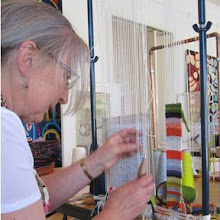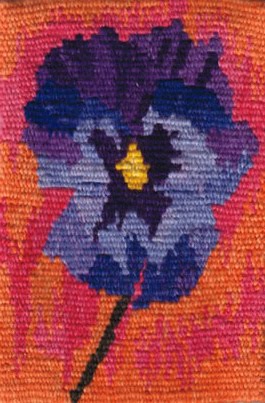
That statement could also be more aptly called 'doing my head in'
For all the years that I have had my Stanley Dann loom I never used it once while I was working my way through my Diploma. I was not because I did not want to weave tapestry on it, but due to the amount of time it takes to warp and set up, along with the cost of the loom waste, (the amount of warp that is wasted) that occurs when you warp up a large loom. My assignments were often samples, woven in different sizes and they seemed to use a different warp and sett each time. Now that I can choose what I want to do I am planning to put my beautiful loom to good use, finally! It has been such a long time since the loom had a warp on it I could not remember what the actual amount of loom waste is? I decided to put a 4cm warp on it and play with the different shades of greys that I dyed last year and just spend some time working on the loom. I love the rhythm and the sound a loom with steel heddles makes when the shafts move. I have four shafts but I only threaded up two of them, although the loom was built for rug weaving I was smart enough when I bought it to buy extra heddles. The biggest problem that I have had is that I was taught to weave tapestry in centimeters and the reed in the loom is in inches. I have three different reeds, one 10 dpi one 8 dpi and one 15 dpi but only one of these is the entire width of my loom. I was taught a system where the warp settings are calculated in groups, 4 centimeters wide and trying to accurately convert this to 1 inch is extremely difficult. I have threading drafts for a 10 dpi reed that came to me via the ATW so I have no need to question if they are accurate. But at the moment I am using an 8dpi reed and that is a completely different ballgame. I recalculated to suit the 8dpi reed but found out that I was one dent out over the 4 centimeters. That may not sound like much, but it is a big mistake if you take it over the entire 50 inches in the reed. I found trying to compare back and forth between inches and centimeters was just doing my head in. The graph paper that I was using had nice big squares but there was no way to measure it. I found this website where you can download different sized graphs. I downloaded the 8, 10 and 15 per inch PDF files. If you want to use them make certain when you print them you choose 'print actual size' and not the 'fit to page' option on your printer. The paper is fantastic and printed off exactly the right size, so I was able to check and recheck with a ruler both in inches and centimeters and I now have the correct threading drafts for an 8 dpi reed. There have been comments made over the years that the warp setting that I was taught could benefit from one more warp in each of the 4 centimeter groups. It is thought by some that they are a little too widely spaced. It is impossible to add one extra warp if you are using a frame loom, unless you use a continuous warp and weave only on the front warps. Adding an extra warp when using a loom with a reed is easy so I have now calculated the drafts for those sets as well. Even though it has taken ages to do, I am grateful that I noticed the mistake now rather that after I had warped up for a large tapestry. I now know the amount of loom waste that I have and can calculate that into the amount of warp that my next tapestry will need. Even though the amount of time that I have spent doing all this seems a bit like wasting time, I am now ready to just get on with something knowing that it will be ok.







PHEW, that sounds *exhausting*!
ReplyDeleteI find the whole 4cm versus dpi/epi very confusing. My new small loom is a Mirrix, which has coils that are set up for epi. I've figured out that the approximate warp sett I like is 10 epi - though I'm not sure whether it is *exactly* the same as my large loom, which is marked in 4cm spacings - confusing!
I'm thinking of getting the Mirrix coils and attaching them to my Ashford large loom, and just calculating in epi for now on ... not sure :\
Hi Michelle, if you have a tapestry on your large loom, put a thread through at the top in the back warps so that you pull them all to the front. Count the warps with a ruler across one inch, then across a few inches. This should give you the number of warps per inch. You can count them on a finished tapestry to give you some idea of the epi. I know what you mean by confusing!!!
ReplyDeleteThis is why I remain on a upright loom with no heddles - basically just a frame- this was the way I was taught originally at art school - and the only time I wove on a loom with heddles was at West Dean in Chichester - and then the loom was warped up by weavers who knew what they were doing!
ReplyDeleteI work mainly on 12 dpi as I love the look and effect of the weave.
Hi Emma Jo. I know what you mean, I was taught the same way but in metric. Australia was imperial until the 1970's when I was in Secondary School. The only thing that made me cross over to metric was learning tapestry as my diploma was taught in metric. But I think I have now nailed it!
ReplyDelete